|
|
Missions
GT-3
GT-10
AS-10
AS-16
STS-1
STS-9
|
|
"...the flight you enjoy most
is the flight you're flying at the time. I enjoyed Apollo. The Gemini was
a nice little machine. I enjoyed that, too."
- John Young, Orlando Sentinel, 9-20-85
|
Gemini 3
March 23, 1965
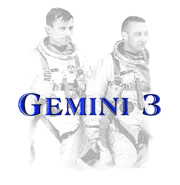
|
The Gemini Program
Information obtained from
NASA
On December 7, 1961, NASA announced
a plan to extend the existing manned spaceflight program; this plan was
officially designated as the Gemini program on January 3, 1962 (named after
the third constellation of the Zodiac with its twin stars Castor and Pollux).
Designed to be an intermediate step between Project Mercury and the Apollo
program, the major objectives of the Gemini program were:
-
To subject two men and supporting
equipment to long duration flights (up to 2 weeks) - a requirement for
projected later trips to the moon or deeper space.
-
To effect rendezvous and docking
with other orbiting vehicles, and to maneuver the docked vehicles in space,
using the propulsion system of the target vehicle for such
maneuvers.
-
To perfect methods of reentry and
landing the spacecraft at a pre-selected land-landing point.
-
To gain additional information concerning
the effects of weightlessness on crew members and to record the physiological
reactions of crew members during long duration flights.
|
Gemini 10
July 18 - 21, 1966
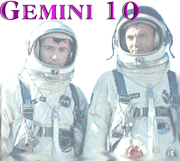
|
All of the major objectives were
achieved with the exception of the land landing, which was cancelled in
1964 when development problems began to impact the program.
Approximately 40 medical and
scientifc experiments and photographic projects were completed in the 10
manned Gemini missions.
Gemini costs totaled $1.29 billion.
-
$790.4 mission for
spacecraft
-
$417.4 million for launch
vehicles
-
$82.3 million for program
support
|
"We need to send people [back]
to the moon and to Mars. And get on with it."
- John Young, Richmond Times-Dispatch,
10-26-98
The Apollo Program
Information obtained from
NASA
Besides landing Americans on
the Moon and returning them safely to Earth, the Apollo program's objectives
were:
-
To establish the technology to meet
other national interests in space.
-
To achieve preeminence in space
for the United States.
-
To carry out a program of scientific
exploration of the Moon.
-
To develop man's capability to work
in the lunar environment.
The Apollo program required a launch
rocket that could lift 7.5 million pounds, a package of complex scientific
experiments that could be deployed by two men, the development of two new
spacecraft (the command module and the lunar module), and a vehicle to
extend the exploration of the surface of the Moon (the lunar rover). At
the peak of Apollo, there were approximately 420,000 NASA and contractor
personnel working on the program.
The astronauts who explored the
Moon totaled 166 man-hours of surface exploration, traversing almost 60
miles. They brought back approximately 850 pounds of lunar samples. Sixty
major scientific experiments were conducted on the Moon and another 34
were conducted in lunar orbit.
|
Apollo
10
May 18 - 26, 1969
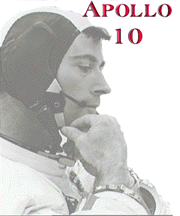
|
Ten lunar landing attempts were
originally scheduled, but 3 were cancelled because of cuts in NASA
funding.
Total Apollo costs were $25
billion.
"Apollo's legacy...is a spinoff
of technology and materials that is being applied to the betterment of
man's everyday life. No other program of technological and scientific exploration
ever has been so compelled or perhaps so able to justify its existence
on the basis of the immediate tangible and sometimes unrelated benefits
it yielded."
- Manned Space Flight - The
First Decade, JSC 08062
|
Apollo
16
April 16 - 27, 1972

|
"Any mission turns me on. They
are all good and I wouldn't want to play any favorites."
- John Young, 1972
STS-1
April 12 - 14, 1981
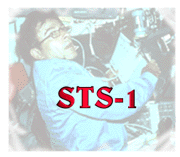
|
STS - Space Transportation
System
Information obtained from
http://www.boeing.com
The Space Shuttle plays a leading
role in driving current technology-not just in terms of space technology,
but for improving our lives here on Earth. In the sustained zero-gravity
environment of the Shuttle, scientist-astronauts have been able to conduct
life sciences research in a variety of medical disciplines. For example,
they've been able to grow protein crystals that are much larger than on
Earth, allowing scientists on the ground to better study their structure
and makeup to assist in the development of new pharmaceuticals to treat
a variety of illnesses.
Earth observation work from the
Shuttle and other spacecraft has saved lives through better hurricane tracking.
We can also predict other weather patterns, such as the El Nino current,
for agricultural planning. Some mineral deposits can be detected from space
with instruments carried aboard the Shuttle.
|
STS-9
November 28 - December 8, 1983
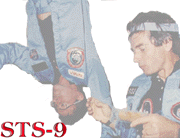
|
The post-cold-war "new age" of
international cooperation is centered around the space program. We're working
productively in a politically non-threatening environment, sharing talents,
technology, resources, and dreams of a peaceful future, with east and west
together in the "enterprise zone" of space.
More than that, the interactions
and working relationships we have established have extended beyond the
space program. New economic relationships and resulting growth opportunities
have already begun to emerge.
It is estimated that the Space
Shuttle alone has created 230,000 new jobs in U.S. private industry and
has stimulated people to earn thousands of advanced degrees in the fields
of science, technology, business, and communications between the U.S. and
other nations. Every tax dollar spent on the space program does up to NINE
dollars worth of work for our economy. The space shuttle program carries
the highest return on investment of any national program in history. And
all four shuttles cost you less than $.01 per day.
|
GT-3
GT-10
AS-10
AS-16
STS-1
STS-9
|



